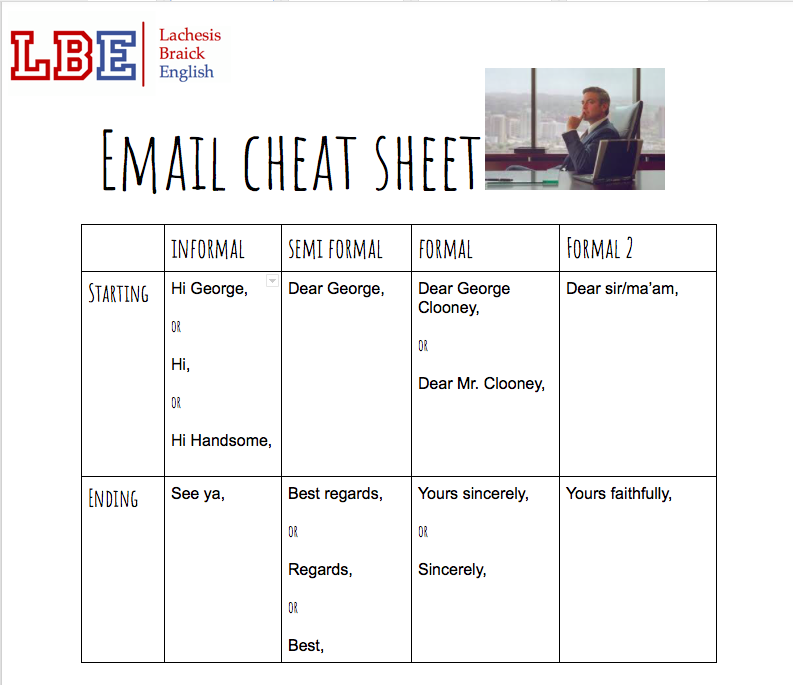Four ways to start and finish your Business English emails
(Para português clique aqui).
There are four main ways to start and finish an email depending on your relationship with the receiver, on how often you're in touch, and your industry.
Let's start sending an email to George Clooney, for instance:
Informal
Unlike what a lot of learners think, most corporate communication, - especially in multicultural organizations - is informal. If you know the person, if you're working on the same project every day or even when you've been in contact multiple times, in most situations you can (and should!) be informal. Unless you are handling a counterpart who is overly formal and you don't talk to very often, things tend to get more and more relaxed for people who are in constant touch regardless of hierarchical levels. Therefore, if you're frequently touching base (coming in contact) with someone, odds are you won't need to start every single one of your emails with "Dear ...". You may have the leeway to say email George Clooney and say:
"Hi,"
or
"Hi George,".
TIP: if you're not sure what to use, use dear + both names and wait for your counterpart's first response. If formality is not essential to you, let them set the tone.
PS: Don't call your colleagues Handsome; that was just a joke. Likewise, avoid referring to colleagues as girls, boys, friends and even guys. Prefer terms such as member of our team and colleague, as they are more professional
Semi- formal
Being semi-formal with a new client/partner in a first contact has the potential to be always a good strategy for people who work for laid back businesses (e.g., tech industry, e-commerce), but it might not be the best option for more formal businesses (e.g., banks/law firms/hotels) when you are contacting someone for the first time, especially if it's a client brining in their money into your business. If you're unsure, ask a more senior colleague or have a look on emails other people have exchanged.
Now here's the catch: if you opt for being semi-formal, you have to end your email saying
"Best regards",
"Best,"
"Regards,".
TIP: When unsure, it's best to start with a more formal approach (using dear and both the same and last name of the person you are getting in touch with.
Formal with a name
Usually in more formal industries and when contacting people we are not often in touch with, we shall start an email with Dear + name + last name (Dear George Clooney). If we want to be a little bit more formal we can also add Mr./Ms. + both names (Dear Mr. George Clooney) or Mr./Ms. + last name (Mr. Clooney).
If you start an email like that, you have to end it with "Yours sincerely." or "Sincerely" and your name
Despite the fact all these forms correct, they might not be the best option for people we talk to on a daily basis, as they might make you sound impersonal and not approachable, which is the opposite of what we want in business. I would personally reserve the formal forms to situations where I am contacting a client I am not nor will I be in constant contact with.
TIP: We only ever use Ms./Mrs in contexts where we have had the liberty to ask that woman if she is married (for example, a bank manager filling out a form). If you don't know a woman's marital situation, use Ms.
Formal if you don't have a name
Sometimes we email a department, or the person in charge of fulfilling a specific role, and this means we don't necessarily know who is going to be reading our message. In cases like that, you may start your email with "Dear sir/ma'am" or even with Dear + person's position, such as "Dear Recruiter".
If you start like that you have to end your email with "Yours faithfully,"
Tip: If you're the client and you are emailing a company about goods or services you've purchased, it is completely up to you choosing to be more of less formal.
Here's a quick summary:
“I wish you very good emails,”





